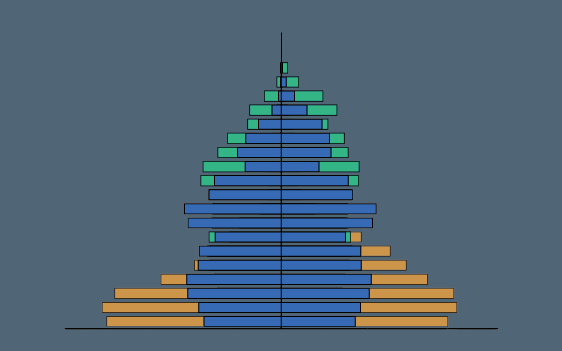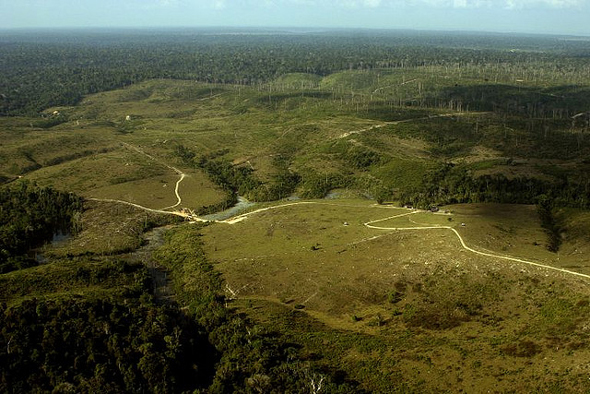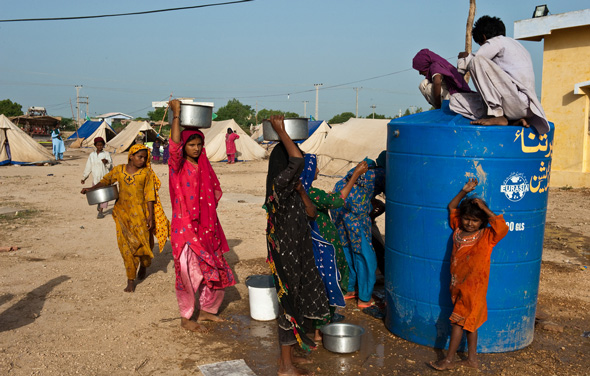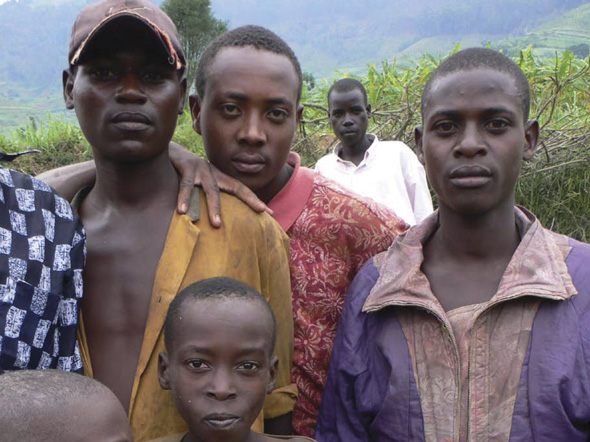-
International Research Institute for Climate and Society
Ethiopia Provides Model for Improving Climate, Other Data Services in Africa
›The original version of this article appeared on the International Research Institute for Climate and Society (IRI).
In developed countries, we are accustomed to having access to long and detailed records on weather and climate conditions, demographics, disease incidence, and many other types of data. Decisionmakers use this information for a variety of societal benefits: they spot trends, fine-tune public health systems, and optimize crop yields, for example. Researchers use it to test hypotheses, make forecasts, and tweak projections from computer models. What’s more, much of these data are just a mouse click away, for anyone to access for free (see examples for climate and health).
Across much of Africa, however, it’s a different story. By most measures, Africa is the most “data poor” region in the world. Wars and revolutions, natural and manmade disasters, extreme poverty, and unmaintained infrastructure, have left massive gaps in socioeconomic and environmental data sets. Reliable records of temperature, rainfall, and other climate variables are scarce or nonexistent. If they do exist, they’re usually deemed as proprietary and users must pay to get access. This is not an inconsequential matter. Without readily available, reliable data, policy makers’ ability to make smart, well-informed decisions is hobbled.
The problem of data access persisted even in Ethiopia, regarded as having one of the better meteorological services on the continent. Thanks to the recent efforts of Tufa Dinku, a climate scientist at the International Research Institute for Climate and Society, the situation has improved considerably.
Continue reading on IRI.
Video Credit: Overview of Ethiopia Climate Maprooms, courtesy of IRI. -
The Missing Links in the Demographic Dividend
›March 9, 2012 // By Elizabeth Leahy Madsen
The “demographic dividend,” a concept that marries population dynamics and development economics, is on the rise in policy circles – Rajiv Shah, Melinda Gates, and African government ministers have all discussed it recently in high-level forums. Most notably for demographers, World Bank Chief Economist Justin Yifu Lin wrote a blog post that focuses on the demographic dividend’s potential to give developing countries a powerful economic boost through declining dependency ratios and a proportionately large working-age population.
-
More People, Less Biodiversity? The Complex Connections Between Population Dynamics and Species Loss
›March 8, 2012 // By Laurie Mazur
“For if one link in nature’s chain might be lost, another and another might be lost, till this whole system of things should vanish by piece-meal.”
~ Thomas Jefferson, 1799This much is clear: As human numbers have grown, the number of species with whom we share the planet has declined dramatically. While it took about 200,000 years for humanity to reach one billion people around 1800, world population has grown sevenfold since then, surpassing seven billion last year.
-
Elizabeth Grossman, Yale Environment 360
How a Gold Mining Boom Is Killing Children in Nigeria
›March 5, 2012 // By Wilson Center StaffThe original version of this article, by Elizabeth Grossman, appeared on Yale Environment 360.
In early 2010, while working in the impoverished rural region of Zamfara in northwestern Nigeria, the group Médecins Sans Frontières – Doctors Without Borders – encountered many young children suffering from fevers, seizures, and convulsions. An unusually high number of very young children, many under age five, were dying, and there were many fresh graves.
The doctors initially suspected malaria, meningitis, or typhoid, all common in the region. But when the sick children didn’t respond to anti-malarial drugs or other antibiotics, one of the physicians began to wonder if local mining activity might be implicated. Historically an agricultural area, Zamfara had been experiencing a small-scale gold rush, thanks to rapidly rising gold prices that encouraged the pursuit of even the most marginal sources of ore. Mining work was taking place in and around the villages and within many of the mud-walled compounds where families were using flour mills to pulverize lead-laden rocks to extract gold.
Médecins Sans Frontières (MSF) doctors sent children’s blood samples for testing and the results revealed acute lead poisoning. Many of the children had blood lead levels dozens, even hundreds, of times higher than international safety standards. Within a week, an emergency medical and environmental remediation team arrived and began to grapple with an epidemic of childhood lead poisoning that is being called unprecedented in modern times. In the past two years, more than 400 children have died in Zamfara, more than 2,000 have been treated with chelation therapy, and thousands more have been – and continue to be – severely poisoned by exposure to pervasive lead dust.
Continue reading on Yale Environment 360.
Photo Credit: “Conflict minerals 1,” courtesy of the ENOUGH Project/Sasha Lezhnev. -
Melanne Verveer and Others at Heinrich Böll Gender Equity and Sustainable Development Conference
›The Gender Equity and Sustainable Development conference, hosted last month by the Heinrich Böll Foundation, was a testament to the increasing importance of gender and sustainability within the international development community. Representatives from the U.S. government, UN, and countless international non-profits, aid organizations, and corporations demonstrated the vital need for collaboration and innovative action when working towards a more sustainable world.
The conference kicked off with an invigorating speech by the Honorable Melanne Verveer, U.S. Ambassador-at-Large for Global Women’s Issues, who called on the international community to acknowledge the “vital role that women can and must play in sustainable development.”
“Putting a spotlight on the critical role of women in stopping climate change will help to harness the immense human capacity of women worldwide,” said Verveer. By advocating for consideration of gender at every level – from grassroots organizing to policymaking – the ambassador painted a picture of a new era of sustainable development.
Step One: Recognize the Problem
A series of four panels followed the keynote address and focused on the intersections between gender inequity, the economy, trade, food and agriculture, and climate change.
There was clear consensus among all the participants that worldwide consciousness of gender inequity can lead to vast improvements in the status of women while also opening the door for new, innovative approaches to sustainable development. The 16 panel members represented numerous groups, from Oxfam America to Gender Action to the Stockholm Environment Institute, and all spoke to the importance of working for larger structural changes while simultaneously shifting more economic, social, and political power into the hands of women by any means possible.
The panelists described a world in which women represent a tremendous, untapped resource for change. Although women only own approximately one percent of titled land worldwide, they own close to 33 percent of business in the developing world and spend two-thirds of consumer dollars worldwide, which they tend to invest in sectors like health and education that benefit the larger community. Verveer said that data also shows women are more likely to pass environmental legislation and that forestry projects involving women have a higher rate of success.
Humanizing Climate Change
The big question of the conference seemed to be: in a world where women are disproportionately vulnerable to the effects of climate change, why aren’t women given more of a voice in the process of creating a more sustainable world?
Marie Brill, a senior policy analyst at Action Aid USA, pointed to the production of biofuels as a poignant example of a sustainable development plan that has had unintended negative consequences for women around the world. In the developing world, women are primarily responsible for food provisioning, yet many social and legal restrictions prevent women from owning land. If women had better access to land ownership and food insecurity would decrease, she said, and crops yields could increase by as much as 20 to 30 percent.
Foreign ownership of large tracts of land, common in the production of biofuels, makes land title even more difficult for women to acquire or maintain. The industry has also led to price spikes for staple crops like corn, said Brill, meaning poor women are sometimes unable to feed their families.
While biofuels provide an alternative fuel source, their production has been managed in a way that ignores the gender-specific implications of the process. By maintaining an awareness of gender, we can ensure that women do not become victims as we move towards a more sustainable world, Brill said.
Liane Schalatek, the associate director of the Heinrich Böll Foundation North America, suggested that a paradigm shift is needed regarding our approach to climate change.
Approaching climate change from a purely scientific and technological perspective is offensively simplistic, Schalatek said. “We need to humanize climate change and bring social equity into the discourse,” she said, emphasizing that “it is our obligation under international human rights objectives and vital to the success of sustainable development to take a rights-centered approach.”
Molly Shane was an intern for the Sierra Club’s Global Population and Environment Program.
Sources: Boston Consulting Group, Council on Foreign Relations, Food and Agriculture Organization of the United Nations, USAID, U.S. State Department, Women Deliver.
Photo Credit: “Climate Risk and Resilience: Securing the Region’s Future,” courtesy of the Asian Development Bank. -
USAID’s Donald Steinberg on Futures Analysis for International Development
›February 28, 2012 // By Stuart Kent Just as the science fiction writer Isaac Asimov explored the idea of predicting the future to influence the world towards a more prosperous, democratic, and peaceful track, so too must USAID try to better understand the challenges of tomorrow, said Donald Steinberg, deputy administrator for the U.S. Agency for International Development, during an address at USAID’s “Future of Development” symposium at the Wilson Center late last year. “Development now is too important to the United States to be left to actions that occur over 1, or 2, or 5, or even 10 years,” he continued. Looking beyond budgetary cycles, Steinberg asserted that “we have to prepare for future development patterns” by analyzing the present.
Just as the science fiction writer Isaac Asimov explored the idea of predicting the future to influence the world towards a more prosperous, democratic, and peaceful track, so too must USAID try to better understand the challenges of tomorrow, said Donald Steinberg, deputy administrator for the U.S. Agency for International Development, during an address at USAID’s “Future of Development” symposium at the Wilson Center late last year. “Development now is too important to the United States to be left to actions that occur over 1, or 2, or 5, or even 10 years,” he continued. Looking beyond budgetary cycles, Steinberg asserted that “we have to prepare for future development patterns” by analyzing the present.
Why Aid Matters
Drawing on the President’s remarks during the UN’s 2010 Millennium Development Goals Summit in New York, Steinberg outlined three reasons why development aid is central to U.S. foreign policy.
First, we all stand to benefit from living “in a world that’s peaceful, that’s democratic, that’s prosperous, that’s respectful of human rights and respectful of human dignity,” he argued.
Second, “a world that is developing is in our economic interest,” he said. “Developing nations are our fastest growing markets abroad,” providing lucrative outlets for U.S. trade and investment. Eighty-five percent of new U.S. exports over the next two decades will find their way to recipients of U.S. foreign aid, he said.
Third, aid impacts national security. Countries that are developing and prospering “don’t spew out large numbers of refugees across borders or across oceans,” he said, “they don’t transmit pandemic diseases, they don’t harbor terrorists, or now even pirates” – in short, “they don’t require American forces.”
Looking to the Future
According to Steinberg, we can take hold of the future by being prepared to grasp opportunities, even if they come in the midst of challenges.
“We’re seeing demographic shifts that are complicating once steady development patterns,” he said, “and we’re seeing more uneven distribution of wealth within countries and between countries.” But “maternal and infant mortality have plummeted [and] literacy rates are skyrocketing.”
“We still see rampant corruption and we still see crackdowns on civil society all around the world,” however Steinberg pointed out that 17 new democracies have emerged in Africa in the last 15 years alone.
On climate change, he drew from recent events in the Horn of Africa. “A changing rain pattern – from a drought every 10 years to what is now basically a drought every year – has brought together a perfect storm of famine, war, and drought,” he said. Yet across the border from Somalia, the situation is markedly different – in part because “USAID has had the capability to work with eight million Ethiopians over the past decade to strengthen their resiliency.”
Each of these shows the opportunity for positive change amidst difficult challenges, if we are prepared.
“We went through a period where we had eliminated our office of policy and planning,” said Steinberg, but over the last few years the newly established Policy, Planning, and Learning Bureau at USAID has brought back an emphasis on futures analysis. “We are now seeking to become…the thought leader in the development field,” he said.
Overall, the total amount of official government aid is small compared to other sources from the United States, said Steinberg – around $30 billion a year (compared to $36 billion in private giving, $100 billion in remittance flows, and $1 trillion in private capital flows). To make the most of that, USAID should be “a catalyst for development,” he said, working in partnership, encouraging technological innovation, and advancing cross-sectoral understanding.
“We at AID like to think in terms of budget cycles,” said Steinberg. “We’re starting to think about fiscal year [20]14, but I want you to start thinking about fiscal year 25 and fiscal year 30. I won’t challenge you to think 30,000 years ahead like Isaac Asimov did, but I think we do have to consider what the lessons of today are teaching us about the future.”
Sources: The White House. -
Stuck: Rwandan Youth and the Struggle for Adulthood (Book Preview)
›
Several years ago, I wrote that the central irony concerning Africa’s urban youth was that “they are a demographic majority that sees itself as an outcast minority.” Since that time, field research with rural and urban youth in war and postwar contexts within and beyond Africa has led me to revise this assertion. The irony appears to apply to most developing country youth regardless of their location.
-
Assigning Value to Biodiversity, and the 2011 Human Development Report
›New research in the journal BioScience reports the aggregate economic benefits of conserving high priority biodiversity areas outweigh the opportunity costs of alternative land uses by a multiple of three (where priority is assigned according to a global index of the mapped distributions of 4,388 threatened terrestrial species). The authors of “Global Biodiversity Conservation and the Alleviation of Poverty,” led by Will Turner, estimate the value of highly diverse habitats to the global poor in terms of direct benefits and potential external payments for ecosystem services. They find these environmental flows in excess of $1 per person, per day, for 331 million of the world’s poorest individuals and conclude by arguing that, “although trade-offs remain…results show win-win synergies…and suggest biodiversity conservation as a fundamental component of sustainable economic development.” (For further discussion of development around biodiversity hotspots, see Population Action International’s work on population growth.)
The 2011 UNDP Human Development Report, Sustainability and Equity: A Better Future for All, builds from the understanding that a “failure to reduce…grave environmental risks and deepening social inequalities threatens to slow decades of sustained progress by the world’s poor majority.” A resilient thread in the report highlights the importance of working to ensure women’s equality and reproductive rights for sustainability, claiming that “meeting unmet need for family planning by 2050 would lower the world’s carbon emissions an estimated 17 percent below what they are today.” The report closes with a wide range of policy suggestions that work towards the goal of equating sustainability and equity, including a supportive discussion of a currency transaction tax as a novel and feasible method of providing climate financing.
These pieces address contradictions between environmentally sustainable behavior and the development imperative. Though both acknowledge that the traditional development model of high intensity economic growth has imperiled the environment upon which the livelihoods of many hundreds of millions depend, they suggest practical ways forward. The Human Development Report in particular adopts some of the strongest language yet, claiming that, “the message is clear: our development model is bumping up against concrete limits.” This honest attempt to work through, rather than around, the tension between development and sustainability is perhaps an indication that we are at last beginning to take seriously the concept of sustainable development.
Showing posts from category development.












